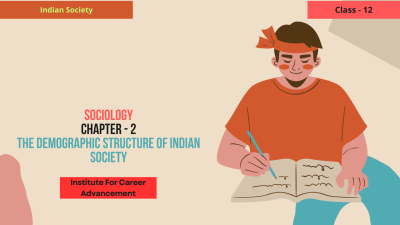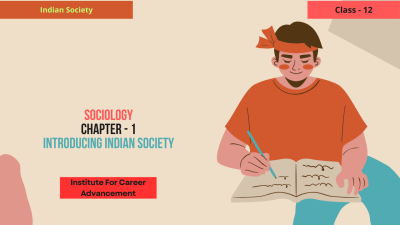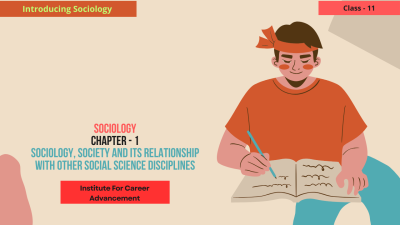Course description
The Demographic Structure of Indian Society unit in Class 12 Sociology focuses on understanding the population dynamics of India and how these dynamics impact social structure, economic development, and cultural practices. This unit provides students with insights into the demographic trends, patterns, and implications for various aspects of Indian society. Here’s an overview of the course content:
Course Overview
1. Understanding Demography
Define demography and its significance in studying human populations.
Introduce key demographic concepts such as population size, density, distribution, and growth rate.
2. Population Growth in India
Analyze historical trends in population growth in India, including factors contributing to rapid population increase.
Examine the implications of population growth on resources, infrastructure, and development.
3. Age Structure of the Population
Discuss the age structure of the Indian population, including the proportion of different age groups (children, working-age population, and elderly).
Analyze the implications of age distribution for economic development, workforce participation, and social services.
4. Sex Ratio in India
Examine the concept of sex ratio and its significance in understanding gender dynamics in society.
Analyze the historical and contemporary trends in sex ratio in India, including factors influencing imbalances.
5. Rural and Urban Demographics
Compare and contrast the demographic characteristics of rural and urban populations in India.
Discuss issues related to urbanization, migration, and their impact on demographic patterns.
6. Literacy and Education
Analyze the relationship between literacy rates, education levels, and demographic factors.
Discuss the role of education in shaping demographic trends and addressing social issues.
7. Fertility and Mortality Rates
Examine the factors influencing fertility and mortality rates in India.
Analyze the implications of these rates for population growth and health care.
8. Migration Trends
Discuss the different types of migration (internal and international) and their impact on demographic patterns.
Analyze the causes and consequences of migration for individuals, families, and communities.
9. Population Policies and Programs
Explore the various population policies and family planning programs implemented in India.
Assess the effectiveness of these policies in managing population growth and promoting demographic health.
10. Implications of Demographic Changes
Discuss the social, economic, and political implications of demographic changes in Indian society.
Analyze how demographic dynamics influence public policy, economic development, and social cohesion.
11. Theoretical Perspectives on Demography
Introduce students to various theoretical perspectives on population studies, including demographic transition theory.
Encourage critical thinking about how demographic factors interact with social issues.
12. Practical Applications
Engage students in projects and discussions that allow them to apply demographic concepts to real-world scenarios.
Encourage students to conduct fieldwork or surveys to gather demographic data and analyze their findings.
Overall Objectives:
Equip students with a nuanced understanding of the demographic structure of Indian society.
Foster critical thinking and analytical skills necessary for analyzing population dynamics and their social implications.
Prepare students for further studies in sociology, public policy, and related fields, enhancing their understanding of demographic challenges and opportunities.
This course aims to provide students with a comprehensive overview of the demographic structure of Indian society, highlighting the importance of demographic factors in shaping social realities and informing policy decisions.
দ্বাদশ শ্রেণীর সমাজবিজ্ঞানে ভারতীয় সমাজের জনতাত্ত্বিক কাঠামো ভারতের জনসংখ্যার গতিশীলতা এবং এই গতিশীলতা কীভাবে সামাজিক কাঠামো, অর্থনৈতিক বিকাশ এবং সাংস্কৃতিক অনুশীলনকে প্রভাবিত করে তা বোঝার উপর দৃষ্টি নিবদ্ধ করে। এই ইউনিটটি শিক্ষার্থীদের ভারতীয় সমাজের বিভিন্ন দিকের জনতাত্ত্বিক প্রবণতা, নিদর্শন এবং প্রভাব সম্পর্কে অন্তর্দৃষ্টি প্রদান করে। এখানে কোর্সের বিষয়বস্তুর একটি সংক্ষিপ্ত বিবরণ দেওয়া হলঃ
কোর্সের সারসংক্ষেপ
1টি। জনসংখ্যার হিসেব বোঝা
মানব জনসংখ্যা অধ্যয়নে জনসংখ্যাবিদ্যা এবং এর তাৎপর্য সংজ্ঞায়িত করুন।
জনসংখ্যার আকার, ঘনত্ব, বন্টন এবং বৃদ্ধির হারের মতো মূল জনসংখ্যাতাত্ত্বিক ধারণাগুলি প্রবর্তন করুন।
2. ভারতে জনসংখ্যা বৃদ্ধি
দ্রুত জনসংখ্যা বৃদ্ধিতে অবদানকারী কারণগুলি সহ ভারতে জনসংখ্যা বৃদ্ধির ঐতিহাসিক প্রবণতা বিশ্লেষণ করুন।
সম্পদ, পরিকাঠামো এবং উন্নয়নের উপর জনসংখ্যা বৃদ্ধির প্রভাব পরীক্ষা করুন।
3. জনসংখ্যার বয়সের কাঠামো
বিভিন্ন বয়সের অনুপাত সহ ভারতীয় জনসংখ্যার বয়সের কাঠামো আলোচনা করুন। (children, working-age population, and elderly).
অর্থনৈতিক উন্নয়ন, কর্মশক্তির অংশগ্রহণ এবং সামাজিক পরিষেবার জন্য বয়স বণ্টনের প্রভাব বিশ্লেষণ করুন।
4. ভারতে লিঙ্গ অনুপাত
লিঙ্গ অনুপাতের ধারণা এবং সমাজে লিঙ্গের গতিশীলতা বোঝার ক্ষেত্রে এর তাৎপর্য পরীক্ষা করুন।
ভারসাম্যহীনতা প্রভাবিত করার কারণগুলি সহ ভারতে লিঙ্গ অনুপাতের ঐতিহাসিক এবং সমসাময়িক প্রবণতা বিশ্লেষণ করুন।
5. গ্রামীণ ও শহুরে জনসংখ্যা
ভারতের গ্রামীণ ও শহুরে জনসংখ্যার জনতাত্ত্বিক বৈশিষ্ট্যগুলির তুলনা ও বৈপরীত্য করুন।
নগরায়ন, অভিবাসন এবং জনতাত্ত্বিক নিদর্শনগুলির উপর তাদের প্রভাব সম্পর্কিত বিষয়গুলি নিয়ে আলোচনা করুন।
6টি। সাক্ষরতা এবং শিক্ষা সাক্ষরতার হার, শিক্ষার স্তর এবং জনসংখ্যাতাত্ত্বিক কারণগুলির মধ্যে সম্পর্ক বিশ্লেষণ করুন।
জনসংখ্যাতাত্ত্বিক প্রবণতা গঠন এবং সামাজিক সমস্যাগুলির সমাধানে শিক্ষার ভূমিকা নিয়ে আলোচনা করুন।
7. জন্মহার ও মৃত্যুর হার
ভারতে উর্বরতা এবং মৃত্যুর হারকে প্রভাবিত করে এমন কারণগুলি পরীক্ষা করুন।
জনসংখ্যা বৃদ্ধি এবং স্বাস্থ্যসেবার ক্ষেত্রে এই হারগুলির প্রভাব বিশ্লেষণ করুন।
8. অভিবাসনের প্রবণতা বিভিন্ন ধরনের অভিবাসন (অভ্যন্তরীণ ও আন্তর্জাতিক) এবং জনসংখ্যার ধরণে তাদের প্রভাব নিয়ে আলোচনা করুন।
ব্যক্তি, পরিবার এবং সম্প্রদায়ের জন্য অভিবাসনের কারণ এবং পরিণতি বিশ্লেষণ করুন।
9টি। জনসংখ্যা নীতি ও কর্মসূচি
ভারতে বাস্তবায়িত বিভিন্ন জনসংখ্যা নীতি এবং পরিবার পরিকল্পনা কর্মসূচিগুলি অন্বেষণ করুন।
জনসংখ্যা বৃদ্ধি পরিচালনা এবং জনতাত্ত্বিক স্বাস্থ্যের প্রসারে এই নীতিগুলির কার্যকারিতা মূল্যায়ন করুন।
10। জনতাত্ত্বিক পরিবর্তনের প্রভাব
ভারতীয় সমাজে জনতাত্ত্বিক পরিবর্তনের সামাজিক, অর্থনৈতিক ও রাজনৈতিক প্রভাব নিয়ে আলোচনা করুন।
জনসংখ্যাতাত্ত্বিক গতিশীলতা কীভাবে জননীতি, অর্থনৈতিক উন্নয়ন এবং সামাজিক সংহতিকে প্রভাবিত করে তা বিশ্লেষণ করুন।
11। জনসংখ্যার উপর তাত্ত্বিক দৃষ্টিভঙ্গি
জনসংখ্যাতাত্ত্বিক পরিবর্তন তত্ত্ব সহ জনসংখ্যা অধ্যয়নের বিভিন্ন তাত্ত্বিক দৃষ্টিভঙ্গির সাথে শিক্ষার্থীদের পরিচয় করিয়ে দিন।
সামাজিক সমস্যাগুলির সঙ্গে জনসংখ্যার উপাদানগুলি কীভাবে যোগাযোগ করে সে সম্পর্কে সমালোচনামূলক চিন্তাভাবনাকে উৎসাহিত করুন।
12টি। ব্যবহারিক প্রয়োগ
শিক্ষার্থীদের এমন প্রকল্প এবং আলোচনায় জড়িত করুন যা তাদের বাস্তব-বিশ্বের পরিস্থিতিতে জনতাত্ত্বিক ধারণাগুলি প্রয়োগ করতে দেয়।
শিক্ষার্থীদের জনতাত্ত্বিক তথ্য সংগ্রহ এবং তাদের ফলাফল বিশ্লেষণের জন্য মাঠপর্যায়ের কাজ বা সমীক্ষা পরিচালনা করতে উৎসাহিত করুন।
সামগ্রিক লক্ষ্যঃ
ভারতীয় সমাজের জনতাত্ত্বিক কাঠামো সম্পর্কে শিক্ষার্থীদের একটি সূক্ষ্ম বোঝার সাথে সজ্জিত করুন।
জনসংখ্যার গতিশীলতা এবং তাদের সামাজিক প্রভাব বিশ্লেষণের জন্য প্রয়োজনীয় সমালোচনামূলক চিন্তাভাবনা এবং বিশ্লেষণাত্মক দক্ষতার বিকাশ ঘটান।
সমাজবিজ্ঞান, জননীতি এবং সম্পর্কিত ক্ষেত্রগুলিতে আরও অধ্যয়নের জন্য শিক্ষার্থীদের প্রস্তুত করুন, জনতাত্ত্বিক চ্যালেঞ্জ এবং সুযোগ সম্পর্কে তাদের বোঝাপড়া বাড়ান।
এই কোর্সের লক্ষ্য হল শিক্ষার্থীদের ভারতীয় সমাজের জনতাত্ত্বিক কাঠামোর একটি বিস্তৃত ওভারভিউ প্রদান করা, সামাজিক বাস্তবতা গঠনে জনতাত্ত্বিক কারণগুলির গুরুত্ব তুলে ধরা এবং নীতিগত সিদ্ধান্তগুলি অবহিত করা।



















